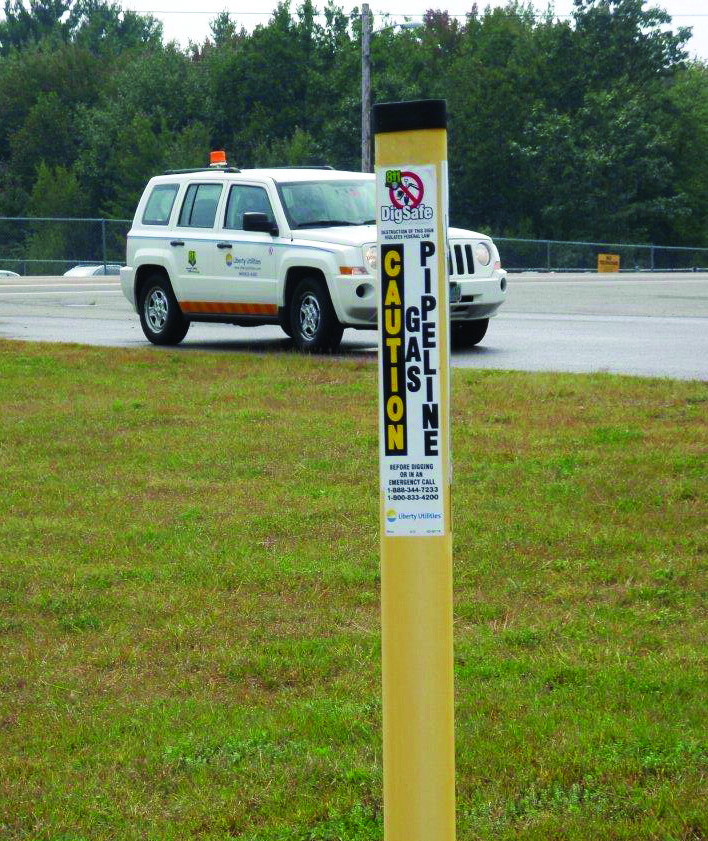Natural Gas Pipeline Safety - Residential - Illinois Gas - Liberty
Safe, Sound and Underground
The natural gas pipeline infrastructure, which includes 2.1 million miles of local utility distribution pipeline, is the nation's safest energy delivery system, according to U.S. government statistics. One reason for these findings may be that gas utilities and pipeline companies, including Liberty, spend a combined $7 billion annually on safety measures. Liberty also has experienced personnel that routinely inspect and maintain natural gas service lines, and service crews are available to respond to emergencies 24 hours a day.
Respecting the Right-of-Way (ROW)
To reduce this risk of pipeline damage, strips of land known as ROWs are sometimes established along a pipeline's path. The ROW can measure from 25 to 150 feet wide.
A ROW can be located within land owned by Liberty or by another party. If the land is owned by another party, we receive an easement, which is an agreement that grants Liberty the right to access the area and to restrict certain activities within the ROW.
When used, a pipeline marker shows only the approximate location of the pipeline and displays the material transported, the operator's name and an emergency telephone number.
The location and depth of a pipeline can vary within a ROW. Be aware that pipeline markers cannot be used to determine the precise location of a pipeline and that the placement of markers is physically prevented in some locations.
Right-of-Way Purpose
A pipeline right-of-way enables Liberty to:
- gain access to the pipeline for inspection, maintenance, testing, or emergencies
- maintain an unobstructed view for aerial surveillance
- identify an area that restricts certain activities to protect a) the landowner, b) the community through which the pipeline passes, and c) the pipeline itself
Pipeline markers may be located where a pipeline crosses roads, railways, waterways and other intervals along the ROW.
Encroachments on a ROW
Permanent structures are not permitted on the ROW because they obstruct access and interfere with our ability to safely operate the pipeline. Prohibited obstructions may include, but are not limited to:
- houses, mobile homes, and trailers
- trees
- garages, tool sheds
- poles
- swimming pools, decks
- septic tanks
Pipeline Markers
Most natural gas pipelines are not marked. Exceptions may include places where a gas transmission line crosses a major road, or is located in a gas pipeline ROW. Standard marking color for natural gas facilities is yellow. Liberty installs above-ground markers to indicate the location of buried pipelines and natural gas lines. These pipeline markers provide the utility name and a 24/7 emergency contact number. Originally, the markers were developed by the gas industry and have since been incorporated into federal regulations governing the industry. The natural gas industry is cooperating with other energy associations to standardize temporary marking of underground utilities to further enhance public safety.
Helpful Resources
We've provided links to some important pipeline related Web sites below, where you can learn more about safety issues.
- National Pipeline Mapping System - https://www.npms.phmsa.dot.gov/
- Office of Pipeline Safety - http://phmsa.dot.gov/pipeline
- Common Ground Alliance - http://www.commongroundalliance.com/
- American Gas Association - http://www.aga.org/Pages/default.aspx
- Northeast Gas Association - http://www.northeastgas.org/
- National "Call Before You Dig" Organization - http://www.call811.com/
- Southern Gas Association - http://www.southerngas.org/ (A resource for linking people, ideas, and information about natural gas operations.)
- Environmental Protection Agency (EPA) - http://www.epa.gov/ (The EPA leads the nation's environmental science, research, education and assessment efforts.)
- NaturalGas.org - http://www.naturalgas.org/ (An educational website covering a variety of topics related to the natural gas industry.)
- National Association of Regulatory Utility Commissioners - http://www.naruc.org/ (NARUC is an association representing the state public service commissioners who regulate essential utility services, such as electricity, gas, telecommunications, water, and transportation, throughout the country.)
- Gas Technology Institute - http://www.gastechnology.org/ (GTI is a not-for-profit research and development organization.)
- Energy Information Administration - http://www.eia.doe.gov/ (Provides extensive data about natural gas and all forms of energy.)
- North American Energy Standards Board - http://www.naesb.org/ (NAESB serves as an industry forum for the development and promotion of standards which will lead to a seamless marketplace for wholesale and retail natural gas and electricity.)
Please note: Liberty provides links to external sites for your convenience. Liberty is not responsible for the content of these sites.
The 811 logo is a registered trademark of the CGA.
